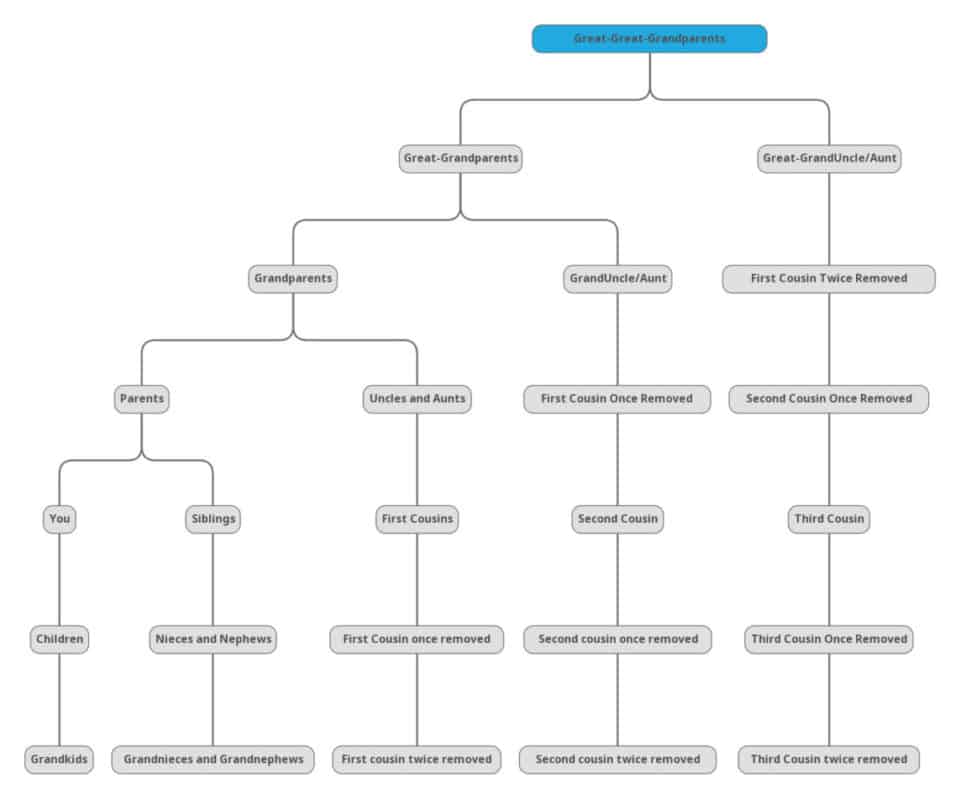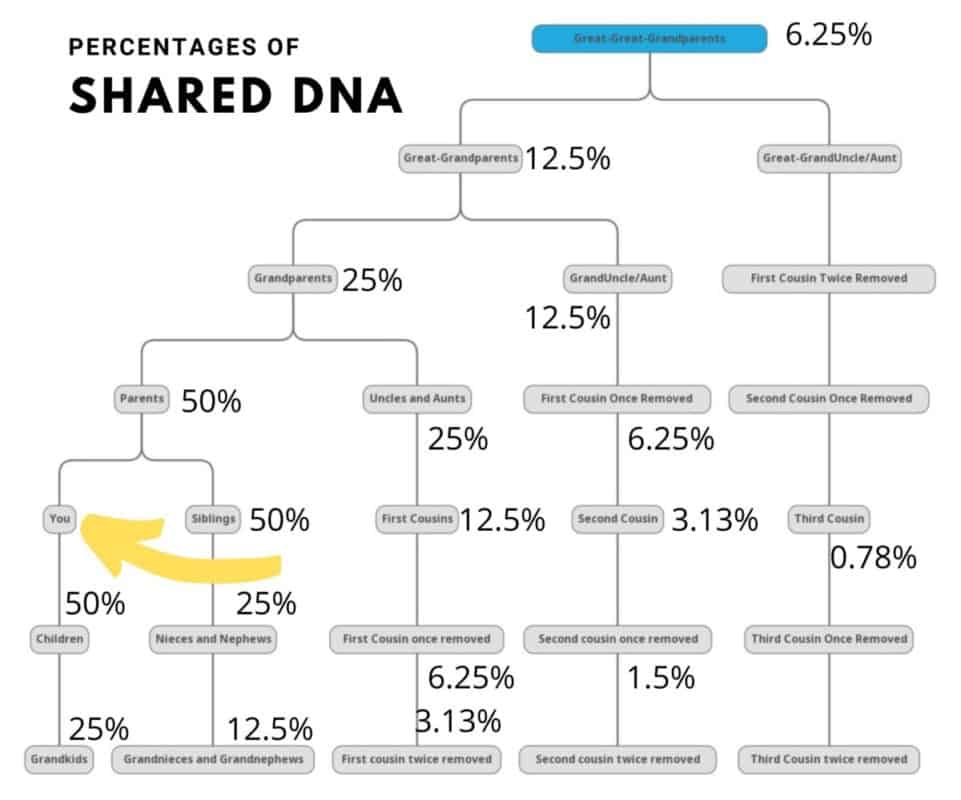Tracing genealogy is a fun thing, but it can bring up some interesting questions – especially in relation to marriages, relations, and potential inbreeding. For example, how many generations until you’re no longer related to someone?
The distance (or the number of generations) required before no longer being considered related to someone depends on how and why you look at it. Legally, you may no longer be considered akin to someone as 2nd cousin. Genetically, it may take 4-5 generations to virtually eliminate shared DNA.
Or if you’ve got a 10th cousin who’s also your best friend, then you might go ahead and consider yourselves still related – even though you don’t meet the legal or genetic definitions of “related” to each other. In any case, let’s dive into the answers, shall we?

4 Generations Until You’re No Longer Legally Related
In the legal sense of looking at how we’re all related, it’s got a slightly different angle than if we were to look at genetics. Based on our quick, we’re-not-lawyers research into this, it seems like there isn’t a general legal definition of what being related even is. There are some specific definitions, but they’re all tied to small, specific laws, like marriage.
In other words, most laws on the books have to do with preventing genetic issues by putting guidelines on how close of a relative you can marry. And as it relates to marriage, most laws say that you have to look at the “degree of consanguinity” – or how many shared relatives you’ve got. In most cases, you can’t marry anyone who is within 2 degrees of consanguinity. (Translated to plain English: within 2 degrees of relationship means you can’t marry them if you have the same grandparents.)
Now, please note that this is a generalization – we couldn’t list the marriage laws for every single state or country and keep this article to a reasonable length. Plus, we’ve already talked about it in more depth in our article on cousins (click here to go read that). Using our infographic provided in that article, I did a quick count – you’d have to go back 3 generations to be at least 2nd cousins.
Well, let’s make it easy: here’s that infographic for your reference. 🙂 But if you want to see the infographic on how to calculate your relation to a cousin without having to draw this, then you’ll definitely need to read the above-linked article.

In any case, this is still a generalization. There are some places where you can marry your 1st cousins. But those places aren’t the general rule, especially in the United States. Some of those places also put limits on child-bearing, so make sure you read your local laws about whom you can legally marry.
Or, if you’d like to be safe, then stick to marrying someone who’s at least a 2nd (or further) cousin. This is generally considered legally acceptable for all states in the USA. And to be the safest of all, please make sure you read your local laws. We aren’t lawyers – we’re genealogists.
5-6+ Generations Until You’re No Longer Related by DNA
Genetically, we don’t share much DNA with our 4th or 5th cousins – and we aren’t genetically related. However, if you’ve regularly spent time with your distant cousins, then you may still feel a familial bond. Even so, let’s figure out why we aren’t technically related to our 4th and 5th cousins (or beyond) on a genetic level.
Based on the laws of averages, we’re able to figure this out using some math. However, because real-life DNA replication doesn’t always follow the laws of mathematics, this is more of a generalization or a good rule of thumb. It won’t always hold up.
However, on average, we get half of our genetic material (DNA) from our mom – and the other half from our dad. Therefore, every generation we go back, we reduce the percentage of shared DNA by half.
If you want to get all mathematical, it’s very literally just dividing that percentage in half. Once you get past your first cousins, though, you’ll need to go to the “once removed” before moving to the next degree of cousins – because of math and genetics. If you don’t, you’ll need to divide by four between cousins.
| Relationship | Shared DNA (Average) |
|---|---|
| Identical Twin | 100% |
| Parent or Child | 50% |
| Siblings (including fraternal twins) | 50% |
| Grandparent or Grandchild | 25% |
| Great-grandparent/child or a 1st cousin | 12.5% |
| 1st cousin once removed | 6.25% |
| 2nd cousin | 3.13% |
| 2nd cousin once removed | 1.5% |
| 3rd cousin | 0.78% |
| 4th cousin | 0.20% |
| 5th cousin | 0.05% |
By the time we go back 5-6 generations (to a 4th or 5th cousin), then the chances of having any shared DNA are very, very small. The odds are small enough that if we went to Las Vegas, neither of us should take that bet. I sure wouldn’t want to take a bet with a 0.20% chance of success!
And just in case pictures work better for you, here you go.

Yes, we just took our infographic and added the percentages to them. So there are a few that are missing – because calculating further degrees of shared DNA past a first or second generation of degrees of cousins gets to be a tiny number very, very quickly. We also didn’t want all of those zeroes to be distracting.
So by the time you’re comparing average DNA similarities for 4th or 5th cousins, odds are that you’ve got a respective 0.20% and 0.05% of the same DNA. Both of those numbers are close enough to zero that, for all practical purposes, let’s go ahead and call them a zero. Fourth and fifth cousins have very little – if any – shared DNA.
How Many Generations Back Until We’re All Related?
If you’re just here for the quick answer (and not the math), then let’s give you that first. Then, we’ll go into math. Genealogists and mathematicians have postulated and calculated that:
- A common ancestor for those of European descent was about 1000 years (40 generations) ago.
- A common ancestor for all of humankind was about 3,400 years (136 generations) ago.
In other words, we’re all very literally distant cousins. So be nice to people – they’re your extended family.
Okay – now are you ready for our best attempts to explain the math? Let’s do this. When you do the math of calculating how many ancestors you have, you start by simply doubling every generation. For example, there’s one of me – but I have two parents, four grandparents, eight great-grandparents, and so on. However, if I go back far enough, then I’ll get to a point where my calculated number of ancestors (who should be alive at that time) exceeds the actual number of people living on the Earth.
So, based on the fact that the number of our ancestors can’t exceed a known population (because that’s just not realistic nor possible), we have to draw some conclusions that are historically supported: at some point, some of my relatives married their own relatives.
Here is where the math gets tricky enough that we’ll step aside – and let the scientists and actual mathematicians step in. We’ll do that by sharing a cool quote about how the experts analyzed DNA segments and other data to reach their conclusions.
Ralph and Coop calculated that these shared segments showed ancestors stretching back some 3,000 years or 100 generations. This lends support to Chang’s calculation that by expanding his model from living Europeans to everyone alive on Earth, an all-ancestor generation would have occurred some 3,400 years ago.
(Bell, 2013)
I fully admit to having to rely on mathematicians for calculating this. While I did take and pass college-level math classes, these kinds of calculations aren’t my forte. I do, however, think it’s cool that someone looked at it and figured out a realistic answer to the question.
And while the answer itself is neat, we happen to think that this takeaway is the actual sticking point that we should remember: humankind is a family. We’re all related, even if we don’t share precisely the same DNA. So it’s time we started treating each other like the brothers and sisters that we are.
Isn’t genealogy awesome? If you want more awesome genealogy findings but aren’t subscribed to our newsletter, please fix that – go subscribe to our newsletter right now. It’s totally free and even more awesome.
Related Questions
How Many Generations Are There in 1000 Years? Depending on how you define a generation, 1000 years ago is between 30 and 40 generations ago. To read more about generational calculations, read our article on how to calculate generations (and how many generations ago America was founded).
How Many Ancestors Do I Have in 50 Generations? In 50 generations of unique ancestors (meaning there weren’t any cousin marriages that made an overlap of family names), then you would have 2^50 (or 1,125,899,906,842,624) ancestors in 50 generations. However, marrying cousins was a historically common practice, so the odds are that you don’t have 1.2 quadrillion ancestors in the last 1500 years.
How Many Descendants Will I Have in 10 Generations? In 10 generations, your total number of descendants will depend on how many offspring everyone has. For example, if you (and all of your descendants) have a single child, then in 10 generations, you will have precisely nine descendants. If you and all of your children have two children each, then in 10 generations, you’ll have 1,006 descendants.
Resources
When learning about genealogy, it’s important to learn from various reputable sources. These are the sources used in this article and our research to be more informed as genealogists.
- Average percent DNA shared between relatives. (n.d.). Retrieved August 03, 2020, from customercare.23andme.com/hc/en-us/articles/212170668-Average-percent-DNA-shared-between-relatives
- Bell, S. (2013, August 08). Researcher uses DNA to demonstrate just how closely everyone on Earth is related to everyone else. Retrieved August 03, 2020, from phys.org/news/2013-08-dna-earth.html
- Boyle, A., Editor, S., & News, N. (2013, May 07). All Europeans are related if you go back just 1,000 years, scientists say. Retrieved August 03, 2020, from nbcnews.com/sciencemain/all-europeans-are-related-if-you-go-back-just-1-6C9826523
- Starr, K. C., & Ballard, B. (2020, July 11). How Do Family Trees Work with Cousins? Retrieved August 03, 2020, from genealogypals.com/how-do-family-trees-work-with-cousins/
